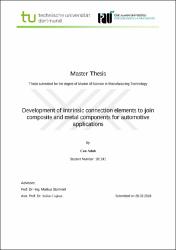Development of intrinsic connection elements to join composite and metals components for automotive applications
Künye
Adalı, C. (2018). Development of intrinsic connection elements to join composite and metals components for automotive applications. Türk-Alman Üniversitesi, Fen Bilimleri Enstitüsü, İstanbulÖzet
Yirmi birinci yüzyılda hafif konstrüksiyon tasarımları farklı alanlara uygulanabilirliği, yakıt tasarrufu ve güvenli sürüş amaçları sebebiyle büyük talep görmektedir. Kompozit malzemeler yüksek birim başına dayanım kuvveti sebebiyle bir hafif malzeme olarak havacılık, otomotiv ve denizcilik sektörlerinde yaygın kullanımdadır. Kompozit parçaları diğer parçaları bağlamak için kullanılan yaygın bir bağlantı yöntemilerinden biri delik delerek cıvatalamadır. Ancak, cıvatalama kompozit malzemenin delinmesini gerektirmektedir ki bu malzemenin dayanımını ciddi ölçüde azaltır. Cıvata bölgesini güçlendirmek ve delme işlemi olmaksızın cıvata deliği oluşturma imkanı sağlayan bir yöntem kompozitin üretimi sırasında cıvata deliği bölgesine kompozitin tabakaları arasına insert yerleştirmedir. Bu tez çalışmasında bir Mercedes benz kamyon parçasının bağlantı bölgesi için üç farklı tip güçlendirme insert'ü tasarlanmıştır. Bunlar metal insert, termoplastik insert ve metal-termoplastik hibrit insert'lerdir. Buna ek olarak, dört tip düz örgü cam elyaf-epoxy kompozit numune üretilmiştir. Bunların üç tanesinin tabakaları arasında insert yerleştirilmişl, bir tanesi delinmiş ve referans olması için insert'süz bırakılmıştır. Numunelere yarı durağan yükleme koşullarında pin çekme testi uygulanmıştır. Test sonuçlarına göre tüm insert'lü kompozit numunelerin son yük taşıma kapasitelerinin arttığı gözlenmiştir (en çok %44 artış). Ek olarak, delinmemiş kompozit numunelerin delik bölgelerinin mukavemetinin referans numuneye göre %74 seviyesinde güçlendiği gözlenmiştir. Öte yandan, insert yerleştirilmiş numunelerin katmanlarında ciddi birbirinden ayrılma gözlenmiştir (3mm'ye kadar). Hepsine ek olarak, testler sonlu elemanlar analizi programı Abaqus'ta modellenmiştir. Analiz ve test sonuçları arasındaki tokluk hatası referans numune için sadece %5, metal insert'lü numune için %39.2 seviyesindedir. Ne yazık ki, elastik bölge sonrası malzeme özellikleri sonlu elemanlar analizi sonucunda iyi seviyede yakınsamamıştır. The lightweight construction is in great demand in the 21st century with the increasing need for fuel saving, safety concerns and customized material properties. For its high specific strength and customizable material properties, the composite materials have found its place as a major lightweight material in aerospace, marine and automotive industries. One fastening technique to join these composite parts to other components is bolted joining which requires drilling to form the holes. Nevertheless, drilling weakens the properties of the composite enormously. One technique to reinforce the joint is to place inserts in the bearing region during the production of the composite. In this work, three different reinforcement inserts were designed for joint region of a Mercedes-Benz Truck component, namely metal insert (M), polymer insert (P) and metal- polymer insert (MP). Four different types of glass/epoxy, plain weave textile composite (PWTC) specimens were designed. One specimen type is only drilled which is used as reference, and other three specimen types have inserts embedded between their layers. The specimens were tested under quasi-static loading conditions at a two-parallel pinned pull-through test. It is observed that all the inserted specimens have higher ultimate load capacity relative to the reference specimens (up to 44% improvement). Besides, the bearing strength increases up to 74.7% at the non-drilled specimen types. However, placement of inserts leads to significant delamination failure (up to 3mm delamination at polymer inserted specimen). Moreover, the pin pull-through test of reference specimen and metal inserted specimen were modeled in commercial Abaqus FEA software. Stiffness values from FE analysis is in relatively good correlation with experimental stiffness. The stiffness errors for reference and metal inserted specimens are 5% and 39.2% consequently. The non-elastic response of PWTC specimens were not properly represented in the FE models.
Koleksiyonlar
- Tez Koleksiyonu [15]

















